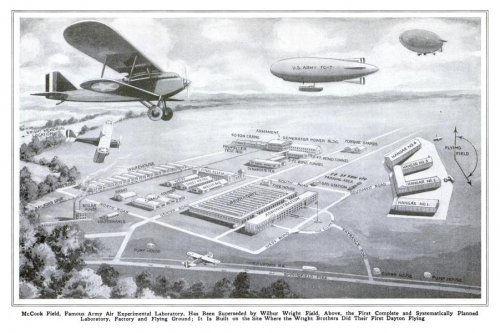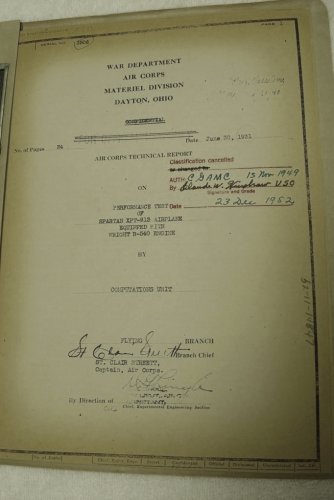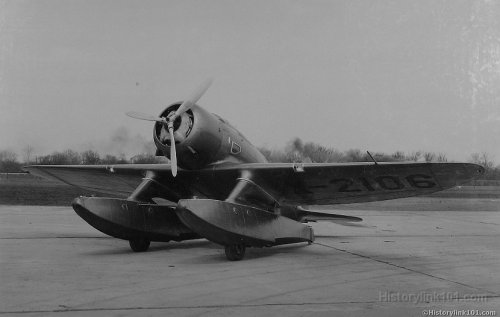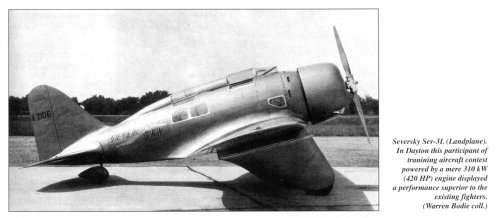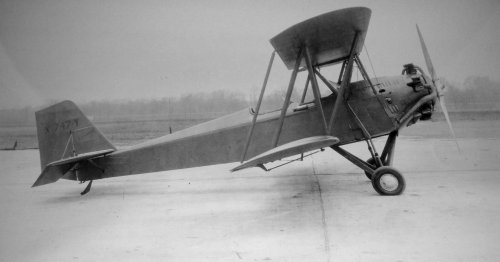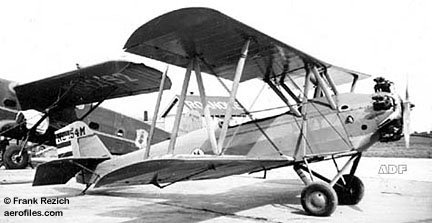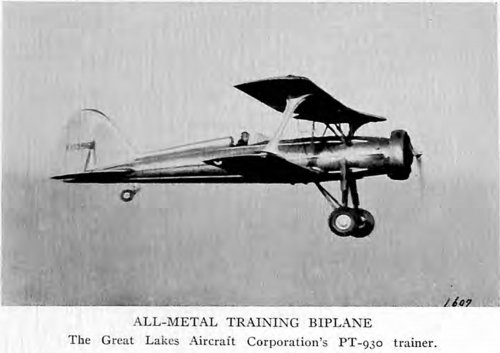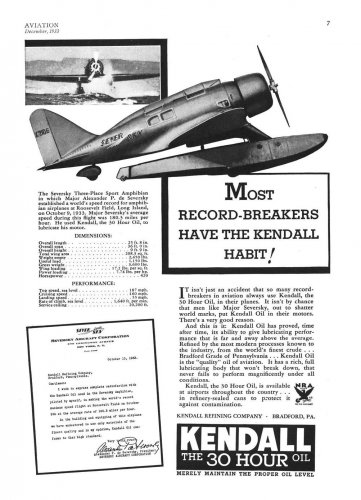- Joined
- 25 June 2009
- Messages
- 13,770
- Reaction score
- 3,041
Between 1918 and 1930, the U.S.A.A.S., and then the U.S.A.A.C, evaluated a number of aircraft at Wright Field that were usually modified by the Engineering division from existing designs. These were allocated a "P-" number ranging from P-1 (a Curtiss Jenny) to P-599 (a Curtiss A-3B). These were mostly military models, but there is a handful of cases where you get the odd civilian type such as the Driggs Dart (P-443) or the Waco 9 (P-447). This list of projects is pretty well documented (and in fact complete up to P-339). Gaps exist though (P-340/-350, P-401/-406, P-408/-420, and two dozen more in the latter part of the list) but these have not been found by the historians who worked on the subject.
Today I would like to start a topic on something that has never been dealt with anywhere before, at least to the best of my knowledge. In the first half of the 1930s, the U.S.A.A.C. evaluated a number of civilian projects for possible purchase. Instead of using the "P-" list from number 600 up, the Air Corps used a whole different and original system of temporary designations which incorporated the planned mission of each aircraft: (A) for attack, (B ) for bomber, (BT) for basic trainer, (C) for transport, (O) for observation, (P) for pursuit, and (PT) for primary trainer. The list started at number 900 and is known to have extended up to number 950. All type numbers were preceded with an "X", indicating their strict experimental status.
Now these designations were no longer simple airframe numbers as in the old system; here each designation corresponded to a different type (with sub-types in a few cases). Very often the manufacturers themselves would use the designations in their records, while the Air Corps would drop them and replace them with appropriate numbers in each of their respective series if purchased.
This designation system and the list of airplanes that are concerned have all but fallen into oblivion, largely because aviation historians and enthusiasts didn't know what to make of them, assuming wrongly that they were in-house designators from the manufacturers.
I would like to share my list with you, bearing in mind that seven numbers are still missing. Also quite a few of the others are devoid of any details and have only made it to the list thanks to the index of the Sarah Clark archives, which contain documents about them (how I wish I could browse through these!)
So here goes:
XP-900 Lockheed low-wing pursuit with monocoque fuselage, retractable gear. Purchased as YP-24 [32-320]
XB-901 Boeing Model 215 bomber with P&W engines. [NX10633; c/n 1459]. Purchased as YB-9 [32-301]
XP-902 Boeing pursuit, no details.SCA
XP-903 Boeing pursuit, no details.SCA
XP-904 Curtiss pursuit, most probably the XP-23.SCA
XB-906-1 Ford bomber conversion of Model 5-AT [X9652]; found unsatisfactory; crashed before delivery
XB-907/A Martin prototype bomber. Purchased as XB-10 [33-139; c/n 434].
XB-908 Keystone low-wing, all-metal bomber project with side-by-side arrangement and retractable wheels, mock-up only.
(also found as the "Travel Air Mono", a Curtiss XB-908A is also quoted)
XC-909 Northrop "Alpha 1" transport [NX127W]. Likely became YC-19.SCA
XC-910 Boeing Model 221 "Monomail" transport [X725W]. Evaluated as the C-18 but kept civil registration.
XO-911 Curtiss observation type. Mock-up built in 1930. SCA
XPT-912 Stearman Model 6-A "Cloudboy" [NC787H]. Not purchased but four procured as YPT-9. (SCA has an "XOP-912", likely a mistake)
XPT-913 Spartan C2-165 low-wing navigation trainer prototype [to NC993N].
XPT-914 Verville AT "Sportsman" primary trainer. Two prototypes [479Y, NC457M]. Purchased as YPT-10.
XBT-915 Stearman Model 6-D "Cloudboy" basic trainer [NC786H]. Not procured but one YPT-9 modified to similar BT-5.
XB-917 American Airplane bomber. No details.SCA
XC-918 Douglas "Dolphin" amphibian transport. [X145W] Likely became one of the Y1C-21 batch. Also found as plain "C-918" and "X-918".
XC-920 Sikorsky transport, likely the S-39C "Sport Amphibion" purchased as Y1C-28 [32-411].SCA
XB-921 American Airplane bomber. No details.SCA
XP-923 Command-Aire pursuit. No details.SCA
XO-924 Thomas-Morse observation type. Ordered as Y1O-42 but not produced.
XP-925/A Boeing Model 218 pursuit with all-metal fuselage and Model D & E Wasp engines [X66W]. Not procured and sold to China.
XO-926 Vought observation type, likely the V-70A demonstrator [X781N].SCA
XP-927 New Standard pursuit. No details.SCA
XC-928 Fairchild "Pilgrim 100-B". [NC754Y] Also found as "928XC" and plain "C-928". Procured as Y1C-24.
XP-929 Northrop pursuit type. No details.SCA
XPT-930 Inland Model T, also Great Lakes Model 41 [X11398]. Not purchased.
XPT-931 New Standard D-32 primary trainer [X747Y]. Not purchased.
XO-932 Thomas-Morse orbservation type [NR33Y]. Purchased as Y1O-41 [30-90]. Later modified as Consolidated Model 23 company hack.
XPT-933 Consolidated Model 21A Trainer [NR784N] with Franklin engine. Not purchased, but led to PT-11 order with Wright engine.
XPT-933A Consolidated Model 21C Trainer. Same aircraft modified with Wasp Junior engine, led to PT-12 order.
XP-934 Curtiss Model 66 "Swift" monoplane fighter. Purchased as the XP-31 [33-178].
XBT-935 Stearman basic trainer. No details.SCA
XP-936 Boeing Model 248. Purchased as XP-/Y1P-26 [32-412; c/n 1678].
XBT-937 Consolidated Model 21C Trainer. Apparently purchased as XBT-6, led to BT-6 order.
XA-938 Detroit (Lockheed) company-owned aircraft said evaluated as Y1A-9 but not purchased, which seems dubious.SCA
XO-939 Detroit (Lockheed) type. No details. "XP-939" also found.SCA
XP-940 Boeing Model 264 all-metal pursuit with retractable gear. Purchased as XP-29, later redesignated YP-29A [34-24; c/n 1942]
XC-941 Kreider-Reisner (Fairchild) "Pilgrim 95". Purchased as the XC-31 [34-26]
XC-942 Bellanca SP-200 Airbus transport [785W?, 10796?]. Likely purchased as Y1C-27 [32-399].
XPT-943 Stearman Model 70 [X571Y], ancestor of Kaydet line. Not purchased.
XP-944 Seversky SEV-3 [X2106], not purchased as pursuit but served as a demonstrator for the BT-8 basic trainer ("XA-944" also found).
XPT-945 Stearman Model 75 [NX/NC14407]. Purchased as XPT-13, prototype of PT-13/PT-17 "Kaydet" series.
XP-948 Vought V-141/-143, the former Northrop 3A (FT) fighter modified. Not purchased.
XB-950 Martin Model 123 bomber, a development of the XB-907. Became the YB-10 prototype.
NOTES:
For years I've searched high and low to get more info and fill in the blanks, but this is the best I've come to so far. Has anyone found a strange X_-900 designator somewhere that they didn't know what to do with? Here's your chance!
Today I would like to start a topic on something that has never been dealt with anywhere before, at least to the best of my knowledge. In the first half of the 1930s, the U.S.A.A.C. evaluated a number of civilian projects for possible purchase. Instead of using the "P-" list from number 600 up, the Air Corps used a whole different and original system of temporary designations which incorporated the planned mission of each aircraft: (A) for attack, (B ) for bomber, (BT) for basic trainer, (C) for transport, (O) for observation, (P) for pursuit, and (PT) for primary trainer. The list started at number 900 and is known to have extended up to number 950. All type numbers were preceded with an "X", indicating their strict experimental status.
Now these designations were no longer simple airframe numbers as in the old system; here each designation corresponded to a different type (with sub-types in a few cases). Very often the manufacturers themselves would use the designations in their records, while the Air Corps would drop them and replace them with appropriate numbers in each of their respective series if purchased.
This designation system and the list of airplanes that are concerned have all but fallen into oblivion, largely because aviation historians and enthusiasts didn't know what to make of them, assuming wrongly that they were in-house designators from the manufacturers.
I would like to share my list with you, bearing in mind that seven numbers are still missing. Also quite a few of the others are devoid of any details and have only made it to the list thanks to the index of the Sarah Clark archives, which contain documents about them (how I wish I could browse through these!)
So here goes:
XP-900 Lockheed low-wing pursuit with monocoque fuselage, retractable gear. Purchased as YP-24 [32-320]
XB-901 Boeing Model 215 bomber with P&W engines. [NX10633; c/n 1459]. Purchased as YB-9 [32-301]
XP-902 Boeing pursuit, no details.SCA
XP-903 Boeing pursuit, no details.SCA
XP-904 Curtiss pursuit, most probably the XP-23.SCA
XB-906-1 Ford bomber conversion of Model 5-AT [X9652]; found unsatisfactory; crashed before delivery
XB-907/A Martin prototype bomber. Purchased as XB-10 [33-139; c/n 434].
XB-908 Keystone low-wing, all-metal bomber project with side-by-side arrangement and retractable wheels, mock-up only.
(also found as the "Travel Air Mono", a Curtiss XB-908A is also quoted)
XC-909 Northrop "Alpha 1" transport [NX127W]. Likely became YC-19.SCA
XC-910 Boeing Model 221 "Monomail" transport [X725W]. Evaluated as the C-18 but kept civil registration.
XO-911 Curtiss observation type. Mock-up built in 1930. SCA
XPT-912 Stearman Model 6-A "Cloudboy" [NC787H]. Not purchased but four procured as YPT-9. (SCA has an "XOP-912", likely a mistake)
XPT-913 Spartan C2-165 low-wing navigation trainer prototype [to NC993N].
XPT-914 Verville AT "Sportsman" primary trainer. Two prototypes [479Y, NC457M]. Purchased as YPT-10.
XBT-915 Stearman Model 6-D "Cloudboy" basic trainer [NC786H]. Not procured but one YPT-9 modified to similar BT-5.
XB-917 American Airplane bomber. No details.SCA
XC-918 Douglas "Dolphin" amphibian transport. [X145W] Likely became one of the Y1C-21 batch. Also found as plain "C-918" and "X-918".
XC-920 Sikorsky transport, likely the S-39C "Sport Amphibion" purchased as Y1C-28 [32-411].SCA
XB-921 American Airplane bomber. No details.SCA
XP-923 Command-Aire pursuit. No details.SCA
XO-924 Thomas-Morse observation type. Ordered as Y1O-42 but not produced.
XP-925/A Boeing Model 218 pursuit with all-metal fuselage and Model D & E Wasp engines [X66W]. Not procured and sold to China.
XO-926 Vought observation type, likely the V-70A demonstrator [X781N].SCA
XP-927 New Standard pursuit. No details.SCA
XC-928 Fairchild "Pilgrim 100-B". [NC754Y] Also found as "928XC" and plain "C-928". Procured as Y1C-24.
XP-929 Northrop pursuit type. No details.SCA
XPT-930 Inland Model T, also Great Lakes Model 41 [X11398]. Not purchased.
XPT-931 New Standard D-32 primary trainer [X747Y]. Not purchased.
XO-932 Thomas-Morse orbservation type [NR33Y]. Purchased as Y1O-41 [30-90]. Later modified as Consolidated Model 23 company hack.
XPT-933 Consolidated Model 21A Trainer [NR784N] with Franklin engine. Not purchased, but led to PT-11 order with Wright engine.
XPT-933A Consolidated Model 21C Trainer. Same aircraft modified with Wasp Junior engine, led to PT-12 order.
XP-934 Curtiss Model 66 "Swift" monoplane fighter. Purchased as the XP-31 [33-178].
XBT-935 Stearman basic trainer. No details.SCA
XP-936 Boeing Model 248. Purchased as XP-/Y1P-26 [32-412; c/n 1678].
XBT-937 Consolidated Model 21C Trainer. Apparently purchased as XBT-6, led to BT-6 order.
XA-938 Detroit (Lockheed) company-owned aircraft said evaluated as Y1A-9 but not purchased, which seems dubious.SCA
XO-939 Detroit (Lockheed) type. No details. "XP-939" also found.SCA
XP-940 Boeing Model 264 all-metal pursuit with retractable gear. Purchased as XP-29, later redesignated YP-29A [34-24; c/n 1942]
XC-941 Kreider-Reisner (Fairchild) "Pilgrim 95". Purchased as the XC-31 [34-26]
XC-942 Bellanca SP-200 Airbus transport [785W?, 10796?]. Likely purchased as Y1C-27 [32-399].
XPT-943 Stearman Model 70 [X571Y], ancestor of Kaydet line. Not purchased.
XP-944 Seversky SEV-3 [X2106], not purchased as pursuit but served as a demonstrator for the BT-8 basic trainer ("XA-944" also found).
XPT-945 Stearman Model 75 [NX/NC14407]. Purchased as XPT-13, prototype of PT-13/PT-17 "Kaydet" series.
XP-948 Vought V-141/-143, the former Northrop 3A (FT) fighter modified. Not purchased.
XB-950 Martin Model 123 bomber, a development of the XB-907. Became the YB-10 prototype.
NOTES:
- Designations with the blue SCA indicate a mention in the Sarah Clark Archives index.
- A Stearman XBT-/XPT-934 appears in the Sarah Clark Archives, probably a mistake for XPT-943.
- A Northrop "XP-938" is most likely a typo for the XP-948.
- Fairchild's Model 91 series were also designated as the XA-942, XA-942A and XA-942B, but it is nowhere near an attack type! Besides the number 942 was already used. Did Fairchild hope to get the type evaluated? Or was it at some point, and the number reused? They even had a second amphibian proposal designated the T-943...
- There is no evidence of this system existing beyond XB-950.
- Existence of the XPT-945 designation is now subject to doubt, as all documents found pertaining to the XPT-13 refer to XPT-943.
For years I've searched high and low to get more info and fill in the blanks, but this is the best I've come to so far. Has anyone found a strange X_-900 designator somewhere that they didn't know what to do with? Here's your chance!


